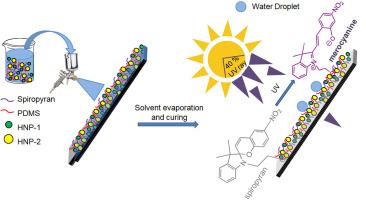One-step fabrication of durable, self-cleaning, anti-icing and UV-shielding coatings
IF 6.3
2区 材料科学
Q2 CHEMISTRY, PHYSICAL
引用次数: 0
Abstract
Glass is widely used in many different areas and applications. In particular, when used in buildings, the high light transmittance and hydrophilic nature of glass can cause problems, such as poor UV protection and dust accumulation. The application of photochromic coatings can improve the optical and self-cleaning properties of glasses. In this study, self-cleaning, UV-shielding glass coatings were fabricated through a one-step, efficient method using spiropyran and SiO₂/polydimethylsiloxane. This superhydrophobic coating, featuring a water contact angle of 153°, exhibited a transmittance of 82–85 % in the visible range. Upon exposure to ultraviolet (UV) radiation, the spiropyran molecule transforms into its merocyanine (MC) form, effectively providing approximately 80 % shielding within the 300–400 nm wavelength range. The merocyanine form spontaneously reverts to the spiropyran form in the absence of UV light. The coating demonstrated exceptional ice-delay performance, postponing ice formation by 389 s compared with that of bare glass. It also demonstrated remarkable stability with 25 cycles of sandpaper abrasion while preserving its structural and functional integrity under diverse conditions, including immersion in organic solvents, exposure to acidic and basic environments, and prolonged UV irradiation for 10 h. This work demonstrates a simple, scalable, and durable approach for developing multifunctional glass coatings that enhance UV protection and self-cleaning properties and offers a promising solution for next-generation smart building materials and sustainable surface technologies.

一步制得耐用、自清洁、防冰和防紫外线涂层
玻璃广泛应用于许多不同的领域和应用。特别是在建筑中使用时,玻璃的高透光性和亲水性会引起问题,例如防紫外线能力差和粉尘堆积。光致变色涂层的应用可以提高玻璃的光学性能和自清洁性能。本研究以螺吡喃和二氧化硅/聚二甲基硅氧烷为原料,通过一步高效制备了自清洁、防紫外线的玻璃涂层。该超疏水涂层的水接触角为153°,在可见光范围内透光率为82 - 85%。暴露于紫外线(UV)辐射后,螺吡喃分子转化为merocyanine (MC)形式,在300 - 400nm波长范围内有效地提供约80%的屏蔽。在没有紫外线照射的情况下,merocyanine形式会自发地还原为螺吡喃形式。该涂层表现出优异的冰延迟性能,与裸玻璃相比,冰的形成延迟了389 s。在不同的条件下,包括浸泡在有机溶剂中,暴露在酸性和碱性环境中,以及长时间的紫外线照射10小时,它也表现出了卓越的稳定性,同时保持了其结构和功能的完整性。开发多功能玻璃涂层的持久方法,增强紫外线防护和自清洁性能,为下一代智能建筑材料和可持续表面技术提供了有前途的解决方案。
本文章由计算机程序翻译,如有差异,请以英文原文为准。
求助全文
约1分钟内获得全文
求助全文
来源期刊

Surfaces and Interfaces
Chemistry-General Chemistry
CiteScore
8.50
自引率
6.50%
发文量
753
审稿时长
35 days
期刊介绍:
The aim of the journal is to provide a respectful outlet for ''sound science'' papers in all research areas on surfaces and interfaces. We define sound science papers as papers that describe new and well-executed research, but that do not necessarily provide brand new insights or are merely a description of research results.
Surfaces and Interfaces publishes research papers in all fields of surface science which may not always find the right home on first submission to our Elsevier sister journals (Applied Surface, Surface and Coatings Technology, Thin Solid Films)
 求助内容:
求助内容: 应助结果提醒方式:
应助结果提醒方式:


